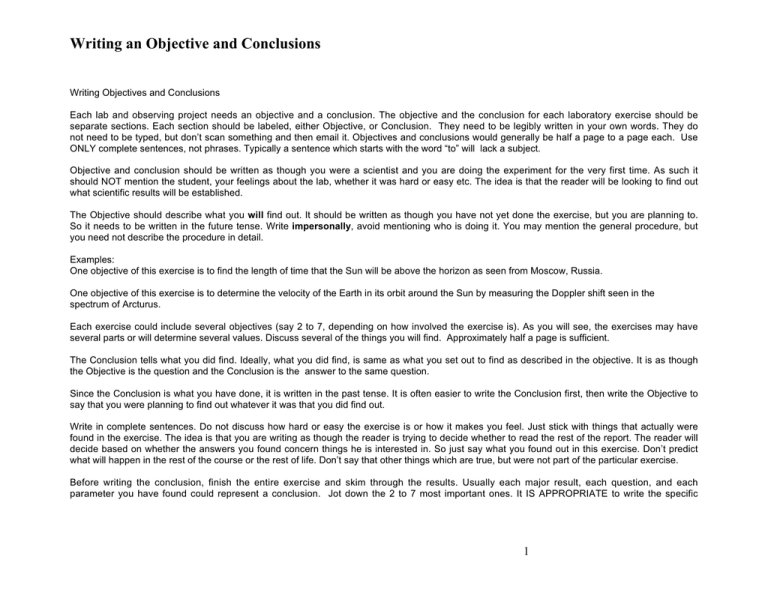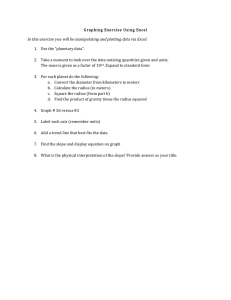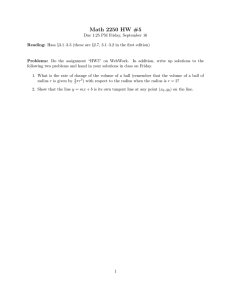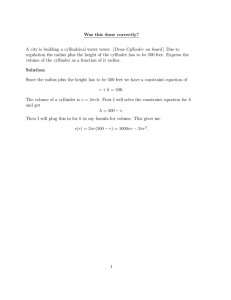Writing an Objective and Conclusions
advertisement

Writing an Objective and Conclusions Writing Objectives and Conclusions Each lab and observing project needs an objective and a conclusion. The objective and the conclusion for each laboratory exercise should be separate sections. Each section should be labeled, either Objective, or Conclusion. They need to be legibly written in your own words. They do not need to be typed, but don’t scan something and then email it. Objectives and conclusions would generally be half a page to a page each. Use ONLY complete sentences, not phrases. Typically a sentence which starts with the word “to” will lack a subject. Objective and conclusion should be written as though you were a scientist and you are doing the experiment for the very first time. As such it should NOT mention the student, your feelings about the lab, whether it was hard or easy etc. The idea is that the reader will be looking to find out what scientific results will be established. The Objective should describe what you will find out. It should be written as though you have not yet done the exercise, but you are planning to. So it needs to be written in the future tense. Write impersonally, avoid mentioning who is doing it. You may mention the general procedure, but you need not describe the procedure in detail. Examples: One objective of this exercise is to find the length of time that the Sun will be above the horizon as seen from Moscow, Russia. One objective of this exercise is to determine the velocity of the Earth in its orbit around the Sun by measuring the Doppler shift seen in the spectrum of Arcturus. Each exercise could include several objectives (say 2 to 7, depending on how involved the exercise is). As you will see, the exercises may have several parts or will determine several values. Discuss several of the things you will find. Approximately half a page is sufficient. The Conclusion tells what you did find. Ideally, what you did find, is same as what you set out to find as described in the objective. It is as though the Objective is the question and the Conclusion is the answer to the same question. Since the Conclusion is what you have done, it is written in the past tense. It is often easier to write the Conclusion first, then write the Objective to say that you were planning to find out whatever it was that you did find out. Write in complete sentences. Do not discuss how hard or easy the exercise is or how it makes you feel. Just stick with things that actually were found in the exercise. The idea is that you are writing as though the reader is trying to decide whether to read the rest of the report. The reader will decide based on whether the answers you found concern things he is interested in. So just say what you found out in this exercise. Don’t predict what will happen in the rest of the course or the rest of life. Don’t say that other things which are true, but were not part of the particular exercise. Before writing the conclusion, finish the entire exercise and skim through the results. Usually each major result, each question, and each parameter you have found could represent a conclusion. Jot down the 2 to 7 most important ones. It IS APPROPRIATE to write the specific 1 Writing an Objective and Conclusions number values you found and the uncertainties associated with them. When you mention your numerical values, be sure that they are consistent with the values you show in the rest of the exercise. If you think there is something wrong with the values, say so. You will be graded on your scientific approach in this part, not on how accurate the values are. Your objective and conclusion should have the same numerical values as are in the lab. The objective and conclusion are the way that you convince the instructor that you know wat you are doing. Information in them is fair game for questions at the instructor meetings. Step 1 What was it I did again? Review the questions, and answers. Jot down the chief topics. If there is one big goal, it's easy. If there are lots of little pieces, jot down the most interesting. For example, for the first lab you Compared measurements of lines in a triangle Practiced with scientific notation and significant figures Found the radius of Earth, used it to find the mass of Earth Found the mass of the Moon and ratio of Earth to Moon masses Plotted radius vs mass of stars and measured the slope of the relationship For stars, the more massive, the larger the radius. The slope of the relationship is 0.8 R/M Height and weight are less strongly correlated than are weight and age. The uncertainty in the weight of a person of height 62 inches is about 67 lb. Mary will reach a location 183 miles from Joe's starting point by a time 36 hours after their meeting. When multiplying numbers, the number of significant figures in the answer is equal to the smallest number of significant figures in the values you multiplied. (no, you don't have to include every little thing) 2 Writing an Objective and Conclusions Step 2 Write the answers in the form of a conclusion, preferably in the order that they were done. Use passive voice, say what was found. Conclusion: It was found successive measurement of the same thing don’t give the identical results. Using Eratosthenes’ method, it was found that the radius of the Earth is 5400km which is 15.33% less than the accepted value. Using 21 5400 km for the radius of the Earth, it was found that the mass of the Earth is 3.63x10 kg. That is 49 times as massive as the Moon. The radius of Mare Imbrium was found to be 500 km. It was found that when multiplying numbers, the number of significant figures in the answer is equal to the smallest number of significant figures in the values you multiplied. For stars, the more massive, the larger the radius will be. The slope of the relationship is 0.8 R/M. Typically the relationship has a spread of 0.4 R around the curve. 3 Writing an Objective and Conclusions Step 3 Write the objective as though you were meaning to discover just what you found. So the objective to go with the conclusion above might be as follows Objective: One objective is to find whether successive measurements of the same thing will give the same answer. Another objective is to find the radius of Earth using Eratosthenes’ method. Using this value, the mass of Earth will be found and it will be compared with the mass of the Moon. Another objective is to determine how many significant figures should be used when finding the product of several numbers. The radius of Mare Imbrium will be found. The relationship between the radius and mass of stars will be explored, Step 4 Switch the order of the pages so that the Objective comes first, staple and turn in with your lab. (but use your OWN words and numbers) Don't do Objective: is to review and refresh our math skills. (This is not complete sentence. It does not acquaint the reader with what specifically will be done. It only discusses the effect on the student.) Conclusion: I really learned a lot in this lab. It was hard at first, but then I caught on. This review give us skills which will be useful in the rest of the astronomy lab. The reader still doesn't know what you have done, since you've only addressed emotions. That is, until you predict the future! Stick to saying what specifically was done. You really cannot predict whether the results will be useful. Objective: Find out the size of the Earth. Find mass of Earth. Find the relationship between the mass and radius of stars. . These sentences are relying on the word "objective" to be the subject. As written they are commands, e.g. " Find out how fast Trucker D goes.", rather than phrases. It is not considered polite to have commands in this sort of document. Conclusion: We plotted the radii of stars with mass 4.129, 2.515, 3.613… This is too much detail. Summarize so the reader can decide whether to read the entire document. 4 Writing an Objective and Conclusions Conclusion: We filled out the tables and answered the questions in the lab. This doesn’t tell what you found out. It just sounds like you really have no idea. 5


